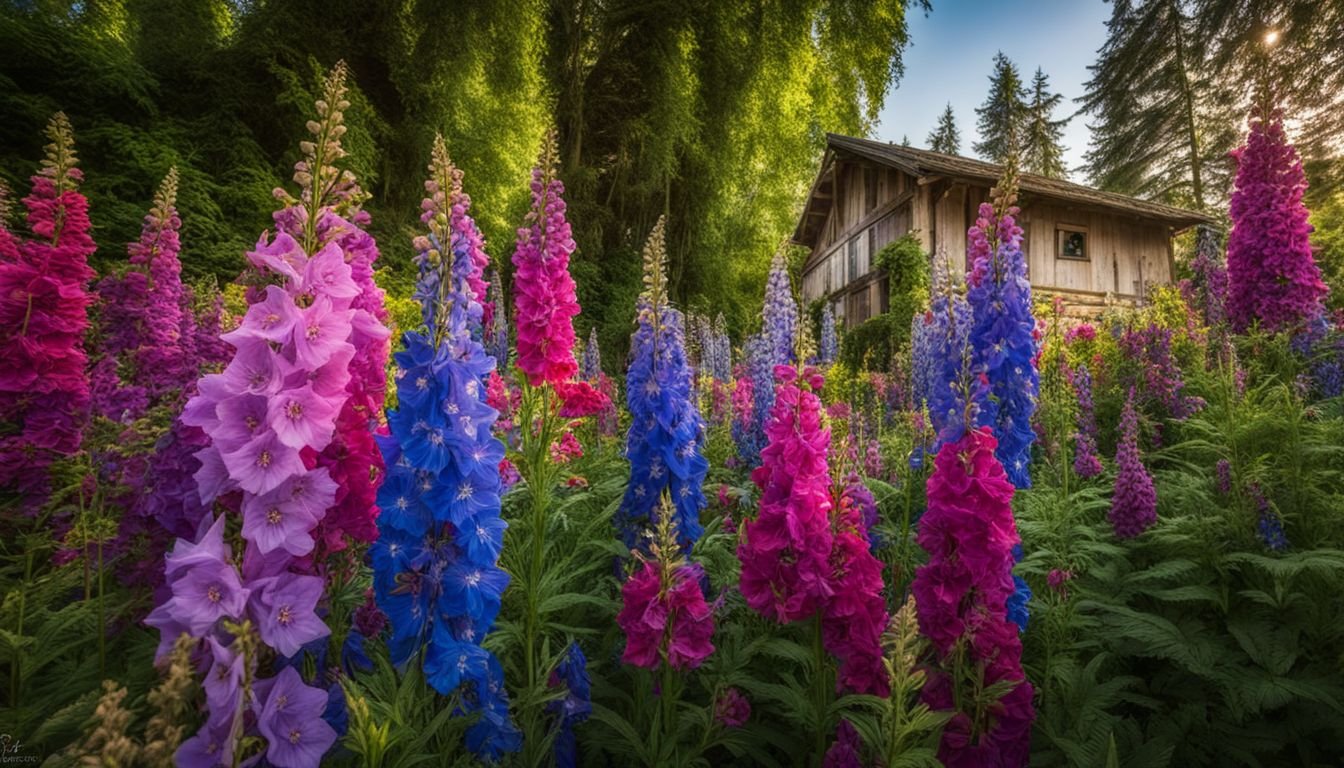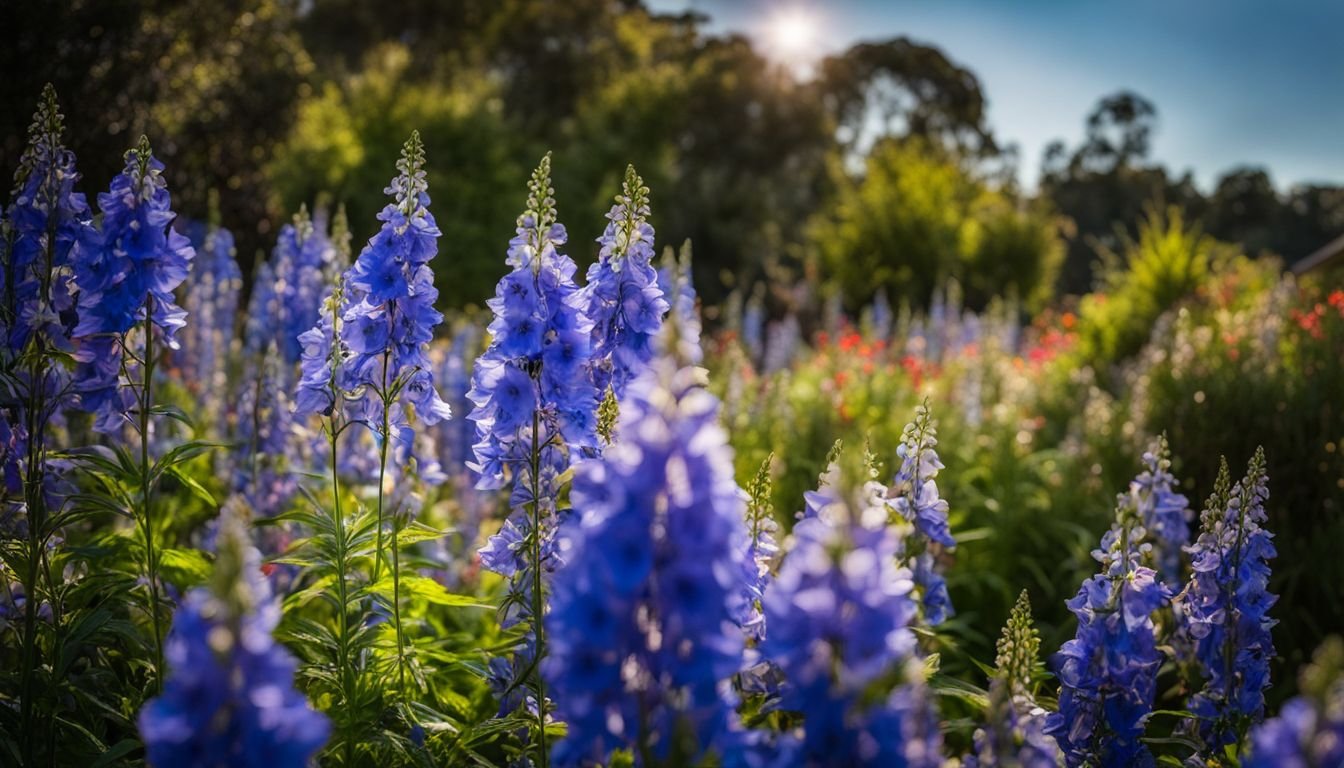Gardening in Australia’s a bit of a unique beast, isn’t it? Especially when you’re trying to coax those breathtaking but somewhat temperamental Delphinium Pacific Giants from the soil.
It’s like these stunning perennials have a mind of their own, leaving loads of us gardeners scratching our heads and muttering under our breath about what more they could possibly want.
You’re chasing that picture-perfect postcard image — those towering spires laden with blooms — only to find your efforts falling just short.
Well, you’re certainly not on your lonesome with this one. We’ve been down that same garden path, puzzled as to why our delphiniums are acting all stubby and shy instead of shooting up towards the sky.
Fuelled by shared gardening woes—and realising that forking out $5.55 each time for a pack of Delphinium Pacific Giants seeds means we’ve really got skin in the game—we rolled up our sleeves and dug deep into finding out what makes these beauties tick.
So, consider this article your trusty companion through thick and thin mulch alike. Whether it’s cut flowers you’re after to brighten up the indoors or you fancy setting off your cottage garden with washes of blues and purples, we’re here to guide you every step of the way.
Welcome to gardening confidently! Your dream delphinium display is closer than ever.
Key Takeaways
- Plant Delphinium Pacific Giants in sunny spots with free-draining soil and mix the bed with well-rotted manure to give them a strong start.
- Keep the soil moist, especially during hot spells, by watering regularly. Applying mulch helps retain moisture and protects the roots from extreme heat.
- Sow seeds in autumn – winter for optimal growth; make sure they stay moist for successful germination.
- Protect these plants from harsh frost by choosing frost – free planting sites or by creating protective microclimates around them.
- After blooming seasons, feed your delphiniums with liquid fertiliser to boost their strength for more flowers and prune dead blooms to encourage new growth.
Understanding Delphinium Pacific Giants

Delving into the world of Delphinium Pacific Giants opens up a realm filled with majestic colours and striking forms. These plants boast an impressive display that can transform any cottage garden into a picturesque scene, beckoning every plant lover to explore further.
Botanical Features
Delphinium Pacific Giants boast tall flowering stems that captivate onlookers with their large, vividly coloured flowers. These beauties open from the base to the tip, showcasing a range of purples, blues, and pinks that add a splash of colour to any garden.
They stand out in cottage gardens and create an enchanting atmosphere.
These perennial plants thrive under full sun or semi-shade conditions. Reaching heights and spreads of up to 1.5 metres, they are perfect for adding vertical interest in your outdoor spaces.
With low water use requirements, they suit Australia’s diverse climate zones perfectly—from the temperate zone of Victoria to the cooler climates in Woollongong and Launceston.
Let’s now explore how many seeds you might need to plant these towering beauties in your own garden space.
Approximate Seed Count
We understand the excitement and anticipation that comes with sowing new plants in our gardens. Knowing the seed count is crucial for planning, especially with something as stunning as Delphinium Pacific Giants. This beauty not only enhances the aesthetics of our gardens but also brings a piece of the majestic Pacific into our Australian homes. Let’s delve into the specifics of the seed count for these magnificent plants.
| Product | Seed Count |
|---|---|
| Delphinium Pacific Giants | 100 seeds |
Each packet of Delphinium Pacific Giants we offer contains precisely 100 seeds. This count serves as a guide for gardeners across Australia, facilitating strategic planning and planting. Whether you’re looking to create a lush backdrop for your garden or designing a space with towering floral spikes, understanding the seed count helps in achieving your gardening goals.
Moving on, let’s discuss the ideal positioning and care requirements for thriving Delphinium Pacific Giants in Australia.
Cultivation of Delphinium Pacific Giants in Australia

Mastering the art of growing Delphinium Pacific Giants in Australia calls for a deep understanding of their unique needs. We dive into the specifics, from choosing the right spot in your garden to ensuring they thrive through different seasons.
Ideal Positioning
We always choose a sunny spot with free-draining soil for planting Delphinium Pacific Giants. This ensures they get enough light to thrive and prevents water from pooling around their roots, which can cause rot.
Preparing the garden beds with well-composted manure not only enriches the soil but also improves drainage, setting up our delphiniums for success right from the start.
Ensuring these giants receive plenty of cool, temperate conditions mimics their natural habitat and promotes vigorous growth. Given their preference for cooler climates and ample moisture, we make it a point to keep them moist throughout the growing season, especially in areas like Queensland where temperatures can soar.
Now, let’s move on to understanding how to take care of these magnificent plants properly.
Care Requirements
Caring for Delphinium Pacific Giants requires attention to detail and a genuine love for gardening. Let’s explore how we can best nurture these beautiful plants in our Australian gardens.
- Sow Seeds in Autumn-Winter: Kickstart your Delphinium journey by planting non-GMO seeds into trays or pots during the cooler months. Ensure they stay moist, aiding in healthy germination.
- Choose Sunny Spots with Free-Draining Soil: These giants thrive in sunlight. Select areas where they can bask under the sun while ensuring the soil allows water to drain freely. Mixing well-composted manure into garden beds prepares a nutrient-rich home for them.
- Water Regularly During Dry Spells: Their roots are relatively shallow, making them vulnerable in hot conditions. Keep the soil evenly moist, especially throughout those parched periods.
- Mulch to Maintain Cool Root Zones: Applying a layer of mulch helps retain soil moisture and keeps root temperatures down during scorching summer days.
- Ensure Adequate Frost Protection: Although they favour cool climates, frost-free environments promote their well-being—strive to shield them from unexpected late spring frosts.
- Feed With Liquid Fertiliser Post-Bloom: Once the initial blooms have spent, nurturing them with liquid fertiliser can energise the plant for prolonged flowering periods.
- Prune to Encourage Growth and Flowering: Timely removal of dead or spent blooms not only enhances appearance but also stimulates new growth and subsequent blooming phases.
- Consider Microclimate Factors: For gardeners living in warmer parts of Australia, creating a microclimate that mimics their cool temperature preferences could prove beneficial.
More Delphinium and Garden Plant Insights
We often hear misconceptions about the care of delphiniums and other garden plants, especially when it comes to their growth in regions like QLD and Victoria, Australia. It’s crucial to debunk these myths for better gardening success.
For instance, many believe that delphiniums need constant sun exposure. However, in Australia’s cool temperate regions, providing some afternoon shade can actually boost their health and flowering capacity.
Maintaining moisture is another key aspect often overlooked by enthusiasts. Delphinium Pacific Giants thrive when we keep their soil consistently moist but not waterlogged. This practice prevents them from going dormant prematurely during hot spells common in northern Australia’s growing seasons.
Additionally, incorporating well-composted manure as advised enhances soil fertility significantly – a step many skip yet proves vital for lush blooms on tall stems with large flowers unique to this variety.
Conclusion
Caring for Delphinium Pacific Giants in our Aussie gardens brings a touch of magic and color. With proper positioning, regular watering, and timely pruning, these majestic blooms will thrive, enriching our outdoor spaces.
Let’s embrace the beauty they add to our landscapes by following these simple steps. Together, we can ensure that these stunning flowers reach their full potential right here in Australia.
Remember, every plant cared for is a step towards a more vibrant garden.
FAQs
1. How do I keep my Delphinium Pacific Giants moist in Australia’s climate?
To keep your Delphinium Pacific Giants properly moist, water them regularly, especially during dry spells. Adding mulch can also help retain moisture in the soil.
2. Can I grow genetically modified Delphinium Pacific Giants in my garden?
Currently, there are no genetically modified (GMO) varieties of Delphinium Pacific Giants available for gardening. Stick to open-pollinated or traditional seeds for growing these flowers.
3. Why is pruning important for Delphinium Pacific Giants?
Pruning helps maintain the health and appearance of your Delphinium Pacific Giants by removing dead or diseased parts and encouraging new growth, which leads to more flowers.
4. Where is the best place to plant Delphinium Pacific Giants in Geelong or Mackay?
Delphiniums thrive in a spot that receives full sun with well-drained soil. Whether you’re in Geelong or Mackay, choose a location that gets at least 6 hours of sunlight daily.
5. What should I do if my Delphiniums aren’t blooming as expected?
Ensure they’re getting enough sun and water; consider using a fertiliser designed for flowering plants too. Sometimes, adding compost to the soil can provide needed nutrients for better blooms.
